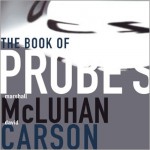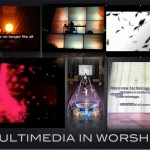Last night I led an evening exploring “Multimedia in Worship” for the Centre for Music, Liturgy and the Arts here in Adelaide. What can you cover in 90 minutes? Well, not everything that I had planned! I can easily spend a seamster on this stuff. But here’s some of what we did.

 ARRIVAL
ARRIVAL
I had a number of different movie loops and images playing on a screen with some ambient music (Lux 1 from Brian Eno‘s “Lux” album), including Marshall McLuhan quotes from “Probes” and some Proost clips.
 “White Lady” – Geoff Boyce’s wonderful video of a mime artist plus Brian Eno‘s “1/1″from “Ambient 1: Music for Airports” and a reading from John chapter 1.
“White Lady” – Geoff Boyce’s wonderful video of a mime artist plus Brian Eno‘s “1/1″from “Ambient 1: Music for Airports” and a reading from John chapter 1.
MEDIA & WORSHIP
I have stacks of printed quotes from which I select items for discussion depending on the session. I handed out a bunch of these. People discussed a quote in pairs and then swapped quotes with another pair and discussed a second quote. Quotes taken from my collection here.
Then a couple of longer quotes to reflect on:
 “Our technological assumptions are deeply cultural. It is right to want worship to be relevant to the people of God; it is entirely different to assume that worship must reflect the technological biases of a particular culture, whether it is high-tech or high-touch.” Schultze questions“the assumption that the most effective worship today must be visually augmented with presentational technologies.”
“Our technological assumptions are deeply cultural. It is right to want worship to be relevant to the people of God; it is entirely different to assume that worship must reflect the technological biases of a particular culture, whether it is high-tech or high-touch.” Schultze questions“the assumption that the most effective worship today must be visually augmented with presentational technologies.”
Quentin Schultze, High-Tech Worship?, Baker Books, 2004.
 Technology and liturgy have been involved in mutual inter-change in every period of human history.”The notion that Christian worship is unconditionally good and healthy and technology is unconditionally bad and unhealthy must also be challenged.” Both “liturgy and technology… have the potential to numb the senses, deaden the conscience, and create climates of anxiety, injustice, and despair.”
Technology and liturgy have been involved in mutual inter-change in every period of human history.”The notion that Christian worship is unconditionally good and healthy and technology is unconditionally bad and unhealthy must also be challenged.” Both “liturgy and technology… have the potential to numb the senses, deaden the conscience, and create climates of anxiety, injustice, and despair.”
Susan White, Christian Worship & Technological Change, Abingdon, 1994.
WORSHIP AS COMMUNICATION
I talked about three shifts in communication and asked the question “What do these mean for worship in terms of both possibilities and problems?” (We could have spent a LOT longer on this.)
a. Information to Experience
- interactivity – we no longer simply receive information, we can engage with it and make choices
- multi-sensory – in providing ‘experiences’, communicators seek to engage more and more of the person – sight, sound, touch, taste, smell
- multi-dimensional – surround sound, multi-screen
- experiences – people no longer just send messages, they offer experiences – ring tones, photo SMS, 3D – communication is a ‘package’
- hyper-reality – not just virtuality, but heightened reality – louder, faster, brighter, gorier
- virtual – from 2D to 3D, immersive, realism
b. Objectivity to Subjectivity
- personalisation – increasingly, information is targeted directly at us based on our personal information and preferences (eg. Amazon)
- commodification – information is less and less free, more and more it is packaged and sold (from government stats to telephone info services to cable TV)
- symbolism – communication is less and less about details and more and more about symbols – that are pervasive and that have a broad appeal
- globalisation – the local and the global are the domains of much communication, greater knowledge of the world and less of our neighbourhood
- propaganda – increasingly, information is used for commercial or political ends – mass media are controlled by a few, motives are rarely displayed
c. Intermediate to Immediate
- more information – information comes to use more often and in more ways (mobile phone, email, SMS, pop-up ads)
- instant messaging – electronic communication has made notions of time and space almost obsolete
- access – access is more immediate (personal accessories) and universal (Internet), yet access is still a major problem for many people
- big & small – size matters. Large plasma screen display and mini mobile devices
The fun thing here is to explore how both sides of the shift – information and experience, objectivity and subjectivity, and mediation and immediacy – are and should be part of worship, and how communication methods and various technologies can contribute to and detract from these (and to what extent it is less about the technology and more about its application/s). We didn’t really have time for all of that, but it makes for an excellent conversation.
WORSHIP & TECHNOLOGY
We talked briefly about the tendency for us to use new technology to simply replace an existing function rather than to rethink the whole, and the challenges and possibilities for worship being bigger than that in a range of ways.
Our typical response to disrupting new technology is to recreate the old environment instead of heeding the new opportunities of the new environment.
Official culture still strives to force the new media to do the work of the old media. But the horseless carriage did not do the work of the horse: it abolished the horse and did what the horse could never do.
The potential of any new technology is always dissipated by its users involvement in its predecessors.
Marshall McLuhan
So…
- Think Multisensory not Multimedia – all senses, not just screen, multi-directional
- Think Participation not Presentation – use multimedia to involve people as authors, editors, use it to foster engagement, conversation, response
- Think Icon not Illustration – not media to simply make a point but to invite people into divine encounter
- Think Flow not Focus – how does the media function as part of the whole worship event
- See Technology as Gift not Gate – let technology enable the people of God to share their gifts, rather than it being the exclusive domain of those who ‘get it’.
BIBLE AS MULTIMEDIA
We looked at several examples of opening the Scriptures using film. I could have spent two days on this, easy.
a. The Prodigal Son – Rembrandt’s famous painting plus “Barber’s Adagio for Strings” – a series of close-ups of the painting with the whole image revealed at the end. Read with the NRSV version.
b. Mark 7:1-23 – A silent movie made with the young people at Rosefield Uniting Church. This and the next two clips represented involving locals to make movies.
Mark 7:1-23 from Craig Mitchell on Vimeo.
c. Lego Jesus – Matthew 6:24-34 – a movie made with the young people at Rosefield Uniting Church.
Two Masters – Matthew 6:24-34 from Craig Mitchell on Vimeo.
d. News Report – Luke 21:5-19 – a movie made with the young people at Rosefield Uniting Church using BoinxTV.
Luke 21 from Craig Mitchell on Vimeo.
e. Isaiah 53 with X-Rays and Cello
This is a clip that I made and have used in Holy Week on a few occasions. Stock images that are x-rays of human bones, reading selected verses from Isaiah 53, and amazing solo cello from Rufus Cappadocia – “Prayer” from “Songs for Cello”
f. “House on the Rock” – Holy Moly
An example of the excellent videos produced by Sparkhouse in Minnesota. Holy Moly is a serious of animated cartoon-style videos for primary school age. One of the nice things about them is that the characters talk with sounds rather than a particular language. We use the videos a lot in our church. Here’s a sample:
You can find some Holy Moly freebie samples here.
g. “40” – Jesus’ Forty Days in the Wilderness
Si Smith has a brilliant set of 40 images portraying Jesus’ time being tested after his baptism. They are available from Proost as a movie. Early on I asked him for copy of each image, and I made my own movie using a song from The Dead Texan called “A Chronicle of Early Failures, Part One.” Brilliant music and a great example of music as a soundtrack.
ONLINE RESOURCES
A few online resources that I mentioned:
Multimedia and Design Resources – on my Mountain Masala blog
Ambient Music & Soundscapes – on my Mountain Masala blog
Multimedia in Ministry – Facebook group
CLOSING
I showed a clip from the Time-Life Jesus DVD of Jesus based on Luke 5. The movie is pretty mixed but this clip is fantastic as it opens up a picture of Jesus as being human. It is wonderful.
That’s about it…
I was going to talk about polychronic and monochronic cultures and high-context and low-context communication (as per Edward T. Hall), and about visual design, and show a million more clips, and examples of worship service stuff, but that was it for now.
Leave a Reply